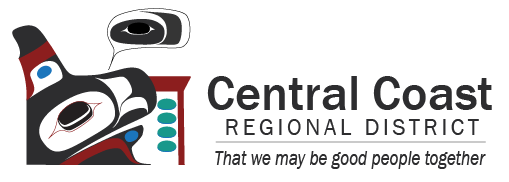The Central Coast Regional District (CCRD) is a regional government under British Columbia's Local Government Act. Incorporated in 1968, the CCRD serves a population of less than 4,000 residents and provides local and regional protective, recreational, environmental, and transportation services to area ratepayers.
The CCRD's electoral area boundaries encompass and area of 24,000 square kilometres nestled in the heart of BC's central coast. Home to a vast temperate rainforest rich in biodiversity and wildlife, endless Pacific Ocean coastline, inlets, and islands, towering glacial mountains, and pristine watersheds, the Central Coast constitutes some of the world´s most spectacular and untouched scenery and natural beauty, and is teeming with rich biodiversity and wildlife.
The CCRD's governance body is made up of five electoral areas that include the Wuikinuxv Nation, Heiltsuk Nation (Bella Bella), and Nuxalk Nation communities, as well as the several unincorporated communities of Bella Coola, Hagensborg, Firvale, Stuie, Denny Island, Ocean Falls and Rivers Inlet. Without municipalities, the Central Coast Regional District is the only regional district in British Columbia to be providing services to only Indigenous peoples, unincorporated communities, and rural areas.
CCRD Mandate
The Local Government Act prescribes the purposes of regional districts as follows:
s. 185 recognizing that regional districts are an independent, responsible, and accountable order of government within their jurisdiction, the purposes of a regional district include:
- providing good government for its community
- providing the services and other things that the board considers are necessary or desirable for all or parts of its community
- providing for stewardship of the public assets of its community, and
- fostering the current and future economic, social, and environmental well-being of its community
Broadly, everything that the Central Coast Regional District does fits into three categories: area specific services, regional services, and advocacy.
The first category is to provide area-specific services such as fire protection, water systems and street lighting to constituents within defined service areas. These services are generally established through regional district bylaw and are confined to small geographic areas outlined in the establishing bylaw.
The second category is to provide services to the entire region, where it doesn´t make sense to duplicate services for each area, or where British Columbia requires service provision under the Community Charter or Local Government Act or other enabling legislation such as the Emergency Program Act. Examples are Community Economic Development, Emergency Preparedness, and regional Library services.
The third category involves efforts to influence the Federal or Provincial Government through various advocacy initiatives mandated by the Board of Directors on behalf of constituents in the region.
The CCRD's efforts, including potentially establishing new services, existing service enhancements, as well as advocacy priorities, are steered by the Board of Director's mandated Strategic Plans. CCRD residents are encouraged to speak to their area director regarding input on our current strategic plan.
Did you know? Fact Sheets about the CCRD and governance in the region are available on our website! Please visit the Governance page for more information about the most recent Diagnostic Governance and Service Delivery Study.
